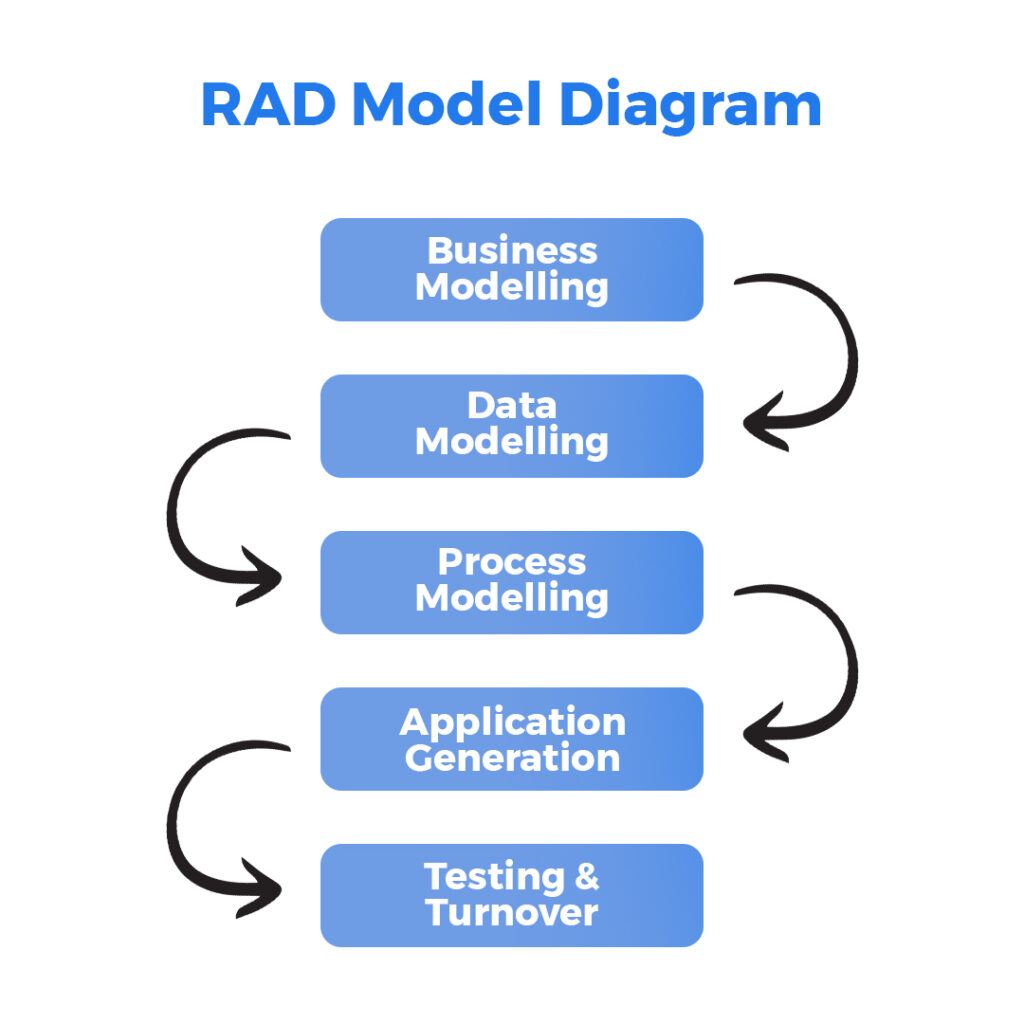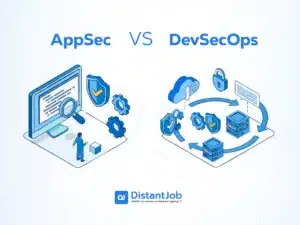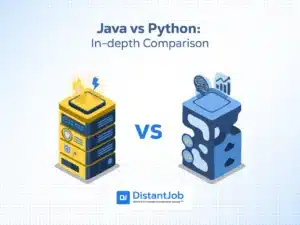Application development methodologies, ranging from traditional (Waterfall) to modern (iterative/RAD/low code/AI-driven), help teams structure their workflow around the creation of a product and also establish the type of flexibility they have during the entire development process.
Traditional methodologies, such as Waterfall, ensure that you adhere to a rigid structure. Sign-off on each stage is required before proceeding to the next stage. Rapid development (RAD) methodologies are designed to be faster and more iterative.
Rapid Development was built as an efficient, quicker, and seamless way to create an app from the design phase to deployment. By using it, you won’t have to rework from the start whenever you need to introduce a new feature or if your client rejects an update/version. Today, those types of methodologies include visual (low/no-code environments) and AI-driven coding tools, letting product owners drag-and-drop new features, while automated DevSecOps gates keep quality in line.
This piece will give you an understanding of what the RAD methodology is about and its advantages and disadvantages. With this information, you will be able to make an informed decision on whether to use it in your application development process or not.
What is the RAD Model?
Rapid Application Development (RAD) is an iterative software development methodology that is prototyping based. This includes small cross-functional teams using visual (low/no-code), AI-driven, and DevOps/DevSecOps to deliver working software in a matter of days. RAD sacrifices a rigid design process for more user feedback and faster time to value.
Put simply, modern RAD turns “rework” into “refactor on the fly.” Whether a stakeholder rejects a screen or regulatory rules shift, you tweak the model, regenerate the app, and redeploy—often in the same afternoon.
Using this development life cycle, developers can:
- Make changes to the design.
- Remove or add features.
- Edit interfaces.
They can do all these without affecting the whole process while also dealing with changing requirements, as they happen, based on client/user feedback. This translates into rapid prototypes for testing and additional improvements.
4 Main Phases in the RAD Model
While the RAD model supports total flexibility and modifications, it functions on four core phases or steps that control the development process:

1. Requirements Planning
At the start, application development separates itself from the conventional software development models. It does not require the developer to sit with end users to get a detailed list of specifications. Rather it requests broad requirements.
In a half-day to two-day Joint Application Development (JAD) session, product owners, designers, developers, and, where necessary, users sit together (usually remotely/online) with the goal of capturing the application’s requirements (business benefits, application’s target state, requirements/constraints/ regulations, quality, and definition-of-done). The outcome is a set of user stories, application requirements, and a backlog of features to be delivered, rather than detailed specifications.
2. User Design ⇄ Prototyping Loop
At this phase, the actual development happens.
Designers and developers work with end users to iterate within hours/days on prototypes (high fidelity prototypes built in the tool/ AI-driven tool) to be presented to users. UI changes, data model updates, and minor feature changes can be done in one session and approved by the appropriate stakeholders. This iterative process ends with approved look-and-feel and the workflow.
3. Construction
The third phase includes turning the design output of the second phase into a hardened version of the prototype (excluding testing, SAST/DAST, and CI/CD integration). It is less risky since much of the solution has been designed and built and most important aspects are mostly non- functional requirements and policies.client and the developer.
4. Cutover (Test → Deploy → Train)
At the testing phase, the product is checked closely against all user requirements to make sure that it functions as demanded. Testing (system, regression, etc.) is automated in the pipeline, data conversion is done, observability features are enabled, and in a go-live stage-gate meeting, the application is deployed to production, and reports/training are delivered to launch.
Rad Model Advantages and Disadvantages
| ✅ Pros—Why Teams Still Pick RAD | ⚠️ Cons—Where RAD Bites Back |
Time-to-value in days, not months. AI coding copilots and low-/no-code accelerators now trim 30-50 % off build effort. | It needs hands-on stakeholders. RAD collapses if product owners, UX designers, and domain experts don’t attend frequent reviews. |
| Continuous user alignment, working prototypes every sprint keep business and IT on the same page, slashing rework. | Scope-creep risk, easy tweaks tempt teams to keep adding “just one more feature.” Lock an MVP exit-criterion. |
| SaaS low-code plans often start under €50/user/month; no big up-front tooling fees. | Vendor lock-in, visual platforms may export to Docker or OpenAPI, but rewrites are still painful; scrutinize SLAs and exit options. |
| Built-in connectors & composable components | Without policy-as-code and DevSecOps gates, documentation and audit trails can lag behind the rapid pace. |
| Early risk exposure | It works only for projects that require speed. |
| High component reusability | Quality depends on team skill |
Advantages of RAD Model
In 2025, the most significant benefits of RAD development come from the convergence of three key enablers (visual [low/no-code], AI-driven code generation and automated DevOps/DevSecOps pillar)which include accelerated time to value, better business/IT alignment and reduced defects, and security issues. Here are the main benefits:
- It offers improved flexibility as developers can adapt to required changes and incorporate new functionalities and features during the build process.
- You can create quick iterations that cut down time frames to make your delivery process a lot more streamlined.
- It is dependent on customer collaboration satisfying every stakeholder such as users, developers, and clients.
- It offers enhanced risk management solutions because code vulnerabilities are fixed before the final release.
- You can carry out integrations at the initial stages and reuse code at any point, which results in a shorter testing time.
- Better defect prevention. Continuous test generation (via AI) and pipeline gating mean bugs surface inside the prototype loop rather than in UAT, improving quality and reducing rework costs
- Fast reviews can be carried out, and hence you achieve more productivity with fewer people.
- Faster ROI & competitive agility
Disadvantages of RAD Model
Though the RAD model is very flexible and is a customer-friendly methodology, it has certain disadvantages if you don’t have the perfect team for it:
- It requires huge collaboration and joint effort from many people and departments. This can become confusing if it isn’t organized or conducted adequately.
- It can lead to problems such as code documentation issues if you have a large team that is mostly filled with new or inexperienced developers.
- It needs slightly more talented developers to carry out iterations and update code during the development process as they’d be quick to understand each aspect of the project.
- Limited scalability for very large, tightly coupled systems
- Rapid Application Development requires customer input at numerous stages, making the process a lot more complex than other methodologies.
- It can be very hard to manage if every stakeholder is not on the same page.
- Vendor lock-in risk with low/no-code platforms. Proprietary runtimes and data schemas make migrations costly.
- AI code-generation hallucinations & supply-chain risk
After comparing the advantages and disadvantages of the RAD model, you have to analyze your current development team to know whether it is suitable for them to use. After all, you have to keep all stakeholders involved during the whole development life-cycle process.
Is RAD the Best Choice for Your Team?
To know if your developer team is ready to incorporate the RAD methodology into their creation process, consider the following questions:
- Is the deadline for your project tight?
- Are your customers open to collaborating during the development process?
- Does your company possess the right resources (developers, coders, and designers) to build a project using this methodology?
- Do you have the budget or means to hire top-notch developer talent who can use the RAD model effectively?
- Do you possess the right technology to use the RAD model?
- Are you able to test your prototypes with customers who will provide truthful, factual, and reliable feedback?
If your answer to the above questions is “yes” then you’re ready to start using the RAD model to develop your project.
Getting Started with the RAD Model
The RAD model can immensely benefit your development process. You ensure your team is both able and ready to collaborate and work extensively with the customer to make sure your prototypes are built and tested efficiently. It works best when your business budget, requirements, and objectives benefit from an iterative and constantly changing process.
If you are unsure how to start or are stuck in the middle of a rapid development procedure, DistantJob, an IT staffing company, can help you and your team hire skilled developers for your project. Or, if you are a developer seeking to put your RAD talent to work, visit here for job opportunities.





